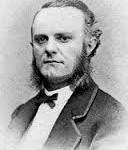The Philadelphia/Bethlehem Connection
When I was a student in Philadelphia, I often had occasion to perform at the Church of the Holy Trinity,
just across Rittenhouse Square from the Curtis Institute of Music. The 1859 church building is beautiful, but I was always impressed by its associated history, and I’m always reminded of it at this time of year. 
The rector of the church from 1862-1869 was Phillips Brooks, famous for his vocal opposition to slavery and for composing the poem, “O Little Town of Bethlehem.”
I also used to walk by a small bronze plaque on a storefront on Walnut Street that marks the site where Lewis Redner, real estate Phillips Brooks
agent and organist at Holy Trinity, penned the tune for the poem by Brooks.

Lewis Redner
The following excerpt is from a commentary by Louis F. Benson from Studies Of Familiar Hymns, First Series (Philadelphia: The Westminster Press. 1924). It tells of the trip to the Middle East that inspired the poetry and the “angel-strain” that inspired the music for this beloved carol.
The Story of the Hymn
It was the sight of Bethlehem itself, one feels very sure, that gave Phillips Brooks the impulse to write this hymn. He was then rector of the Church of the Holy Trinity, in Philadelphia, and had spent a year’s vacation traveling in Europe and the East. “After an early dinner, we took our horses and rode to Bethlehem,” so he wrote home in Christmas week of 1865. “It was only about two hours when we came to the town, situated on an eastern ridge of a range of hills, surrounded by its terraced gardens. It is a good-looking town, better built than any other we have seen in Palestine. . . . Before dark, we rode out of town to the field where they say the shepherds saw the star. It is a fenced piece of ground with a cave in it (all the Holy Places are caves here), in which, strangely enough, they put the shepherds. The story is absurd, but somewhere in those fields we rode through the shepherds must have been. . . . As we passed, the shepherds were still “keeping watch over their flocks or leading them home to fold.” Mr. Brooks returned in September, 1866, and it must have been while meditating at home over what he had seen that the carol took shape in his mind. The late Dr. Arthur Brooks assured the writer that it was not written until 1868.
In the programme of the Christmas service of the Sunday-school of the Church of the Holy Trinity in that year the carol was first printed, and it was sung to the music written for it by Mr. Lewis H. Redner.
Its history as a hymn begins then, and a considerable share of the credit for its popularity must be given to Mr. Redner, at that time organist of the church, superintendent of its mission, and teacher in the church school. The place of the carol in the books is now established, and new tunes have been and will be written for it. But it is safe to say that Mr. Redner’s music was what carried the carol into notice and popularity. If the tune to which it was sung at that service had been unsuccessful, it is unlikely that the carol would have been reprinted or heard again, at least during Bishop Brooks’s life.
With this view of the case it seemed to the present writer well worth while that an account, as circumstantial as possible, of the genesis of hymn and tune should be secured from the one man living who knows it. And standing over Mr. Redner in his Walnut Street office in Philadelphia one winter afternoon, waving aside the modest protests and gently prodding the reluctance of that genial composer, he was happy in obtaining the following written statement of the circumstances:
“As Christmas of 1868 approached, Mr. Brooks told me that he had written a simple little carol for the Christmas Sunday-school service, and he asked me to write the tune to it. The simple music was written in great haste and under great pressure. We were to practice it on the following Sunday. Mr. Brooks came to me on Friday, and said, ‘Redner, have you ground out that music yet to “O Little Town of Bethlehem”?’ I replied, ‘No,’ but that he should have it by Sunday. On the Saturday night previous my brain was all confused about the tune. I thought more about my Sunday-school lesson than I did about the music. But I was roused from sleep late in the night hearing an angel-strain whispering in my ear, and seizing a piece of music paper I jotted down the treble of the tune as we now have it, and on Sunday morning before going to church I filled in the harmony. Neither Mr. Brooks nor I ever thought the carol or the music to it would live beyond that Christmas of 1868.
“My recollection is that Richard McCauley, who then had a bookstore on Chestnut Street west of Thirteenth Street, printed it on leaflets for sale. Rev. Dr. Huntington, rector of All Saints’ Church, Worcester, Mass., asked permission to print it in his Sunday-school hymn and tune book, called The Church Porch, and it was he who christened the music ‘Saint Louis.’”
Do you have a favorite Christmas carol?
50% Complete
Two Step
Lorem ipsum dolor sit amet, consectetur adipiscing elit, sed do eiusmod tempor incididunt ut labore et dolore magna aliqua.